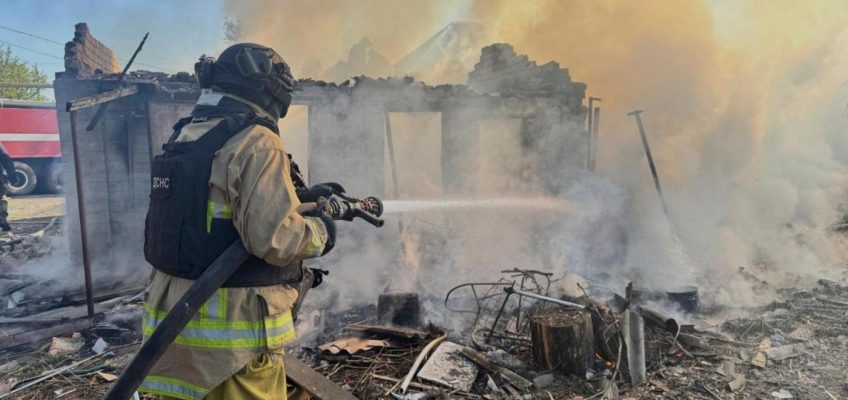By JON GAMBRELL, Associated Press
DUBAI, United Arab Emirates (AP) — Yemen’s Houthi rebels on Monday alleged a U.S. airstrike hit a prison holding African migrants, killing at least 68 people and wounding 47 others. The U.S. military had no immediate comment.
The strike in Yemen’s Saada governorate, a stronghold for the Houthis, is the latest incident in the country’s decadelong war to kill African migrants from Ethiopia and other nations who risk crossing the nation for a chance to work in neighboring Saudi Arabia.
It also likely will renew questions from activists about the American campaign, known as “Operation Rough Rider,” which has been targeting the rebels as the Trump administration negotiates with their main benefactor, Iran, over Tehran’s rapidly advancing nuclear program.
The U.S. military’s Central Command, in a statement early Monday before news of the alleged strike broke, sought to defend its policy of offering no specific details of its extensive airstrike campaign. The strikes have drawn controversy in America over Defense Secretary Pete Hegseth’s use of the unclassified Signal messaging app to post sensitive details about the attacks.
“To preserve operational security, we have intentionally limited disclosing details of our ongoing or future operations,” Central Command said. “We are very deliberate in our operational approach, but will not reveal specifics about what we’ve done or what we will do.”
It did not immediately respond to questions from The Associated Press about the alleged strike in Saada.
Graphic footage shows aftermath of explosion
Graphic footage aired by the Houthis’ al-Masirah satellite news channel showed what appeared to be dead bodies and others wounded at the site. The Houthi-run Interior Ministry said some 115 migrants had been detained at the site.
The rebels’ Civil Defense organization said at least 68 people had been killed and 47 others wounded in the attack.
This is a locator map for Yemen with its capital, Sanaa. (AP Photo)
Footage from the site analyzed by the AP suggested some kind of explosion took place there, with its cement walls seemingly peppered by debris fragments and the wounds suffered by those there.
A woman’s voice, soft in the footage, can be heard repeating the start of a prayer in Arabic: “In the name of God.” An occasional gunshot rang out as medics sought to help those wounded.
African migrants caught in middle of Yemen’s war
Ethiopians and other African migrants for years have landed in Yemen, braving the war-torn nation to try and reach Saudi Arabia for work. The Houthi rebels allegedly make tens of thousands of dollars a week smuggling migrants over the border.
Migrants from Ethiopia have found themselves detained, abused and even killed in Saudi Arabia and Yemen during the war. An Oct. 3, 2022, letter to the kingdom from the U.N. said its investigators “received concerning allegations of cross-border artillery shelling and small arms fire allegedly by Saudi security forces, causing the deaths of up to 430 and injuring 650 migrants.”
Saudi Arabia has denied killing migrants.
Monday’s alleged strike recalled a similar strike by a Saudi-led coalition battling the Houthis back in 2022 on the same compound, which caused a collapse killing 66 detainees and wounding 113 others, a United Nations report later said. The Houthis shot dead 16 detainees who fled after the strike and wounded another 50, the U.N. said. The Saudi-led coalition sought to justify the strike by saying the Houthis built and launched drones there, but the U.N. said it was known to be a detention facility.
“The coalition should have avoided any attack on that facility,” the U.N. report added.
That 2022 attack was one of the deadliest single attacks in the yearslong war between the coalition and the Houthi rebels and came after the Houthis struck inside the UAE twice with missiles and drones, killing three in a strike near Abu Dhabi’s international airport.
US military says over 800 strikes conducted in campaign so far
Meanwhile, U.S. airstrikes overnight targeting Yemen’s capital killed at least eight people, the Houthis said. The American military acknowledged carrying out over 800 individual strikes in their monthlong campaign.
The overnight statement from Central Command also said “Operation Rough Rider” had “killed hundreds of Houthi fighters and numerous Houthi leaders,” including those associated with its missile and drone program. It did not identify any of those officials.
“Iran undoubtedly continues to provide support to the Houthis,” the statement said. “The Houthis can only continue to attack our forces with the backing of the Iranian regime.”
“We will continue to ratchet up the pressure until the objective is met, which remains the restoration of freedom of navigation and American deterrence in the region,” it added.
The U.S. is targeting the Houthis because of the group’s attacks on shipping in the Red Sea, a crucial global trade route, and on Israel. The Houthis are also the last militant group in Iran’s self-described “Axis of Resistance” that is capable of regularly attacking Israel.
US discusses deadly port strike
The U.S. is conducting strikes on Yemen from its two aircraft carriers in the region — the USS Harry S. Truman in the Red Sea and the USS Carl Vinson in the Arabian Sea.
On April 18, an American strike on the Ras Isa fuel port killed at least 74 people and wounded 171 others in the deadliest-known attack of the American campaign. Central Command on Monday offered an explanation for why it hit the port.
“U.S. strikes destroyed the ability of Ras Isa Port to accept fuel, which will begin to impact Houthi ability to not only conduct operations, but also to generate millions of dollars in revenue for their terror activities,” it said.
Meanwhile, the Houthis have increasingly sought to control the flow of information from the territory they hold to the outside world. It issued a notice Sunday that all those holding Starlink satellite internet receivers should “quickly hand over” the devices to authorities.
“A field campaign will be implemented in coordination with the security authorities to arrest anyone who sells, trades, uses, operates, installs or possesses these prohibited terminals,” the Houthis warned.
Starlink terminals have been crucial for Ukraine in fighting Russia’s full-scale invasion and receivers also have been smuggled into Iran amid unrest there.




